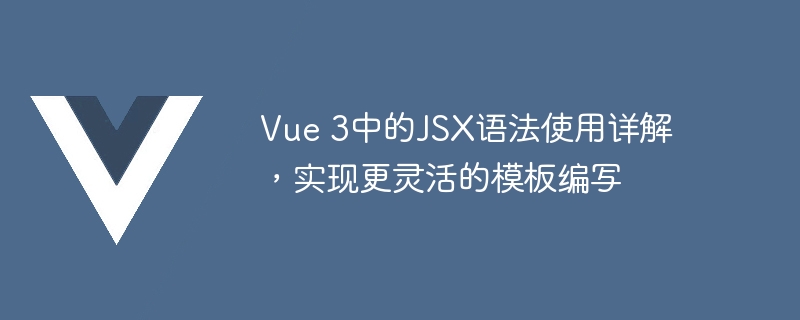

Detailed explanation of JSX syntax in Vue 3 to achieve more flexible template writing
Introduction:
Vue is a very popular front-end framework that provides It provides a declarative template syntax that allows developers to build user interfaces more conveniently. However, in Vue 2, there are certain limitations in the way template syntax is written, which cannot fully meet the needs of developers. In order to solve this problem, Vue 3 introduced JSX syntax, making template writing more flexible. This article will analyze in detail how to use JSX syntax in Vue 3 and give corresponding code examples.
1. What is JSX syntax
JSX is a JavaScript syntax extension that allows HTML-like markup structures to be written directly in JavaScript code. Vue 3 provides native support for JSX, allowing developers to use JSX to write templates for Vue components.
2. How to use JSX syntax
In the Vue entry file (usually main.js), add the following code:
import { createApp } from 'vue' import App from './App' const app = createApp(App) app.mount('#app')
import { h } from 'vue' export default { name: 'HelloWorld', render() { return ( Hello World
) } }
In this example, we create Vue through thehfunction virtual node and returns a JSX expression, making it the component's render function.
import { h } from 'vue' import HelloWorld from './HelloWorld' export default { name: 'App', render() { return ( This is an example of using JSX in Vue 3
) } }
In this example, we pass
import { h } from 'vue' export default { name: 'ConditionalRender', data() { return { show: true } }, computed: { message() { return this.show ? 'This is a conditional render using JSX' : '' } }, render() { return ( {this.message} ) } }
In this example, we use the v-if directive, which is determined based on the value of the show attribute Whether to display the content of the message. By clicking the Toggle button, we can change the value of the show attribute to achieve conditional rendering.
Conclusion:
Through a detailed analysis of the use of JSX syntax in Vue 3, we can find that using JSX syntax can make Vue template writing more flexible. By introducing JSX syntax, developers can use HTML-like markup structures in Vue components to further improve development efficiency. At the same time, JSX syntax also allows us to use Vue instructions and calculated properties in Vue components, making the application logic and rendering more consistent. Therefore, we can flexibly choose to use Vue template syntax or JSX syntax in actual projects, and choose the most suitable way to write Vue component templates as needed.
The above is the detailed content of Detailed explanation of JSX syntax in Vue 3 to achieve more flexible template writing. For more information, please follow other related articles on the PHP Chinese website!